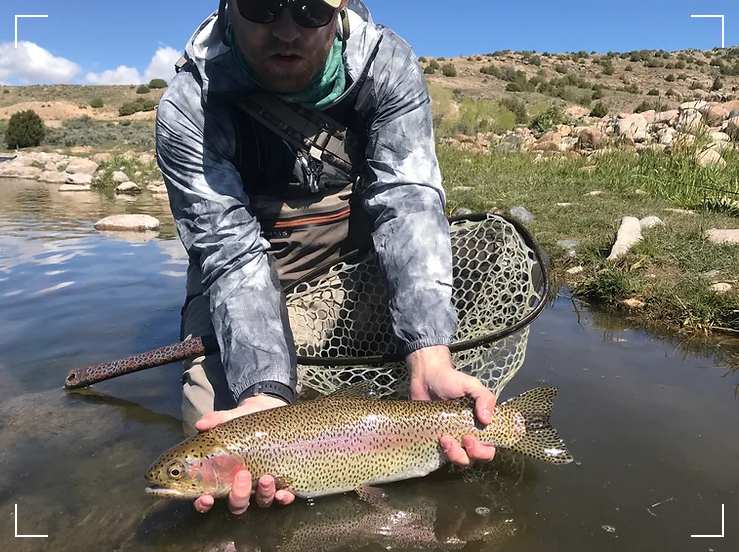Crash Course in Picky Trout Behavior: An Angler's Playbook
Fly fishing graduate school: Welcome to the big-leagues of trout fishing. You better come prepared.

October 2023
In Part 1, we discussed how trout think about their world. Now lets use that knowledge to catch some picky fish!
Here are some go-to moves to consider when fishing to a large, picky trout. Remember, the fish might not eat and you might have better luck moving on to find other fish, but that wouldn’t be nearly as rewarding! So stick with it, here are some ideas for approaching a “technical” trout. These tips should prove especially relevant as we start to head from fall into winter.
Pre-game prep
- Have a variety of fly patterns available to cycle through when a fish starts refusing offerings, including different sizes, colors, and profiles of patterns. Remember from Part 1 that trout can develop and remember very specific search images for their preferred, maximum energy food. By preparing at your tying bench with variations in size, color, and profile you increase your odds of finding a fly that matches naturals as well as a trout’s search image. For example, I'd rather have 3 variations of RS2 pairs than 6 of the same RS2 pattern.
- Come prepared for delicate presentations. Bring light tippets, long rods/soft rods, and lighten your drag. Ditch your indicator and tightline/euro presentations can present flies deeper and faster.
On the water
- Change your casting location, if a fish doesn’t respond, to present your flies from a different angle. You never know if micro-drag might be influencing your presentation, but the fish will tell you if something isn’t right. Also, remember to think about how your dominant arm influences your drift (discussed here).
- Rest the water. After a while, I think a fish loses interest in your continual casting. He's seen your past offerings and already determined that they don't match the criteria for food. If you keep trying the same thing, eventually the fish ignores the offering as he makes up his mind, which is to tune out your presence.
- Try to make him eat it. A fish might be lazy enough to think that it costs less energy to open his mouth and eat the incoming item, then to swim out of the way. I’ve seen it happen, but complex currents or slow flows can make this difficult in certain circumstances.
- Drastically change up flies. Cripples offer a very different profile compared to exact replicas, which might be enough of a difference to get the fish to notice. Similarly, anti-match the hatch could apply. If a trout has a highly specific search image for one item it's possible a different item might have a less refined search image, and a more willing trout.
- Be stealthy. I don’t mean camouflage. I mean, don’t false cast over the fish you hope to hook. Water flicks off your false casts and sprays over the water, adding unneeded disturbances. Watch out for your shadows and sun angles. Don’t climb on top of rocks to cast, your profile becomes much larger. I think army crawling is overkill, but try to match the surroundings. Blend in with tall stream side vegetation like shrubs, trees, or boulders. If that means crouching, or casting from your knees, I say do it.
- Seine the top 2 feet of the water column for clues about hatching or drifting insects. Again, pay attention to size, color, and profile. Kicking up rocks gives you an idea of what’s in the river, but doesn’t clue you into the insects actively moving through the water column.
- Pay attention to your indicator and split shot. Look for low profile, light impact indicators in white or clear. Cast lightly or further upstream to avoid the loud “kerplunk” of split shot as they enter the water.
- Fine tune your tippet. Though fluorocarbon tippet isn’t as supple as monofilament for dry fly fishing, the added transparency of fluorocarbon has proven beneficial to short-range dry fly fishing and nymphing.
- When casting, make sure your line misses on the side with the heavier current, allowing the fly to pass by the fish before you need to recast. If you miss on the eddy side, you might spook your fish by pulling your flies out of the eddy for your recast.
- Use a Davy Knot to tie on your flies. Strong and thin, the Davy’s knot doesn’t create a large profile off of the eye of the hook. This might prove beneficial over a long clinch knot in very technical situations.
- Consider alternative rigs like a drop shot rig or using dropper tags to present your flies.
When the fish takes
- You’ve waited this long, don’t blow it by pulling the fly out of the fish’s mouth. Wait to set the hook until the moment when you see the fish start to move away from where he took your fly, especially if fishing dries. With nymphs, strike quickly.
- Be prepared to “walk the dog”. Have your initial battle strategy planned out once the fight begins. If the fish wants to go downstream, make sure you have a route prepared to chase him. You’re hoping to keep the fish perpendicular to you, or upstream of you. If the fish does get downstream, put your rod tip underwater directly upstream from the fish, the pressure will be applied in a way that coaxes the fish back upstream. It might sound counter-intuitive, but it really works!
These tips might be overkill for many who fish for trout, but we enjoy fly-fishing because it’s inherently the hard way to do things. And if a large picky trout is feeding in a very technical situation, that’s the hardest of hard situations. But that just makes the reward all the more satisfying. So take these tips along, I hope they help.


